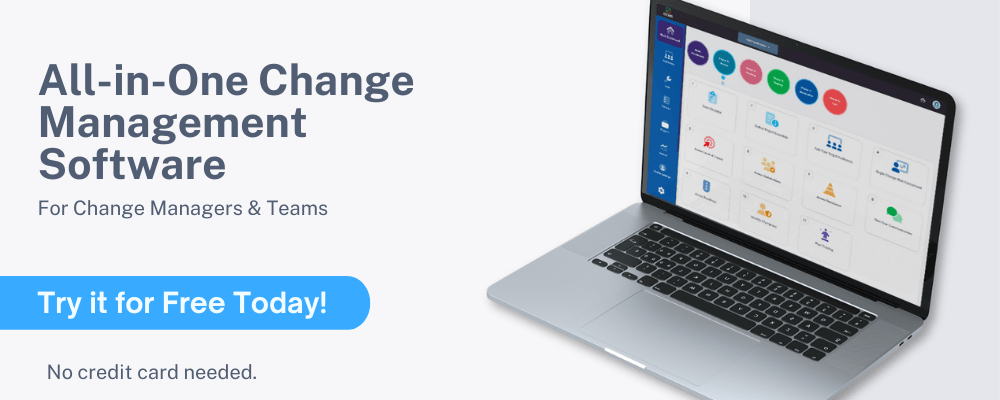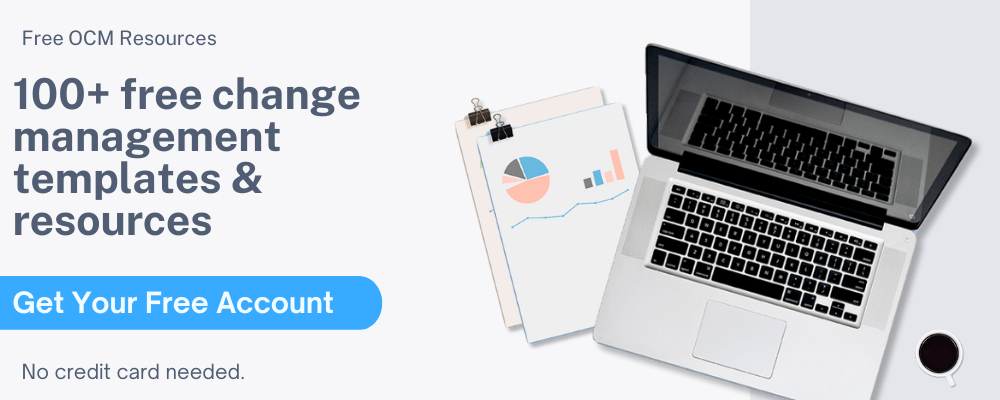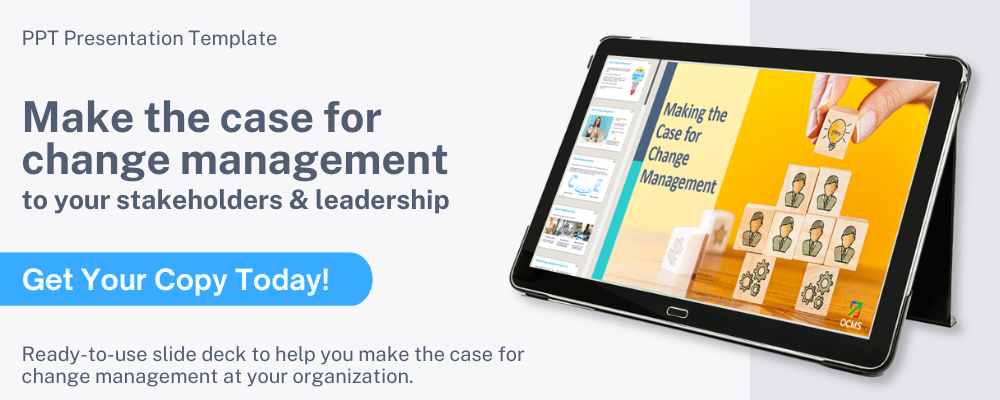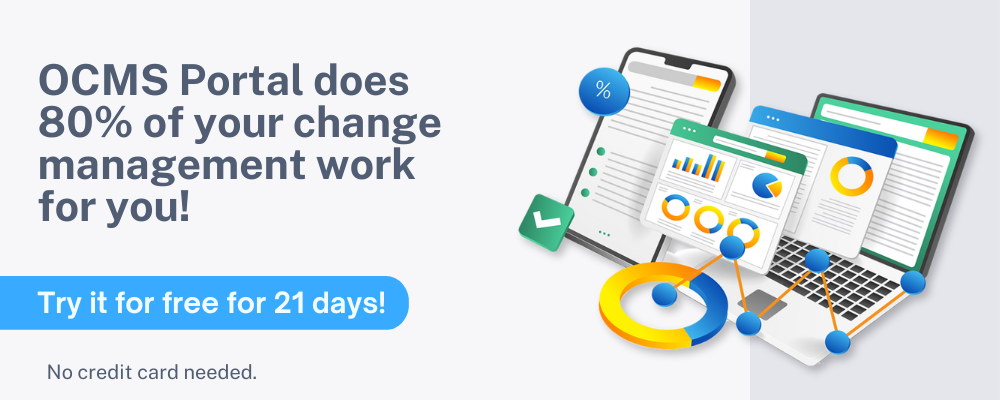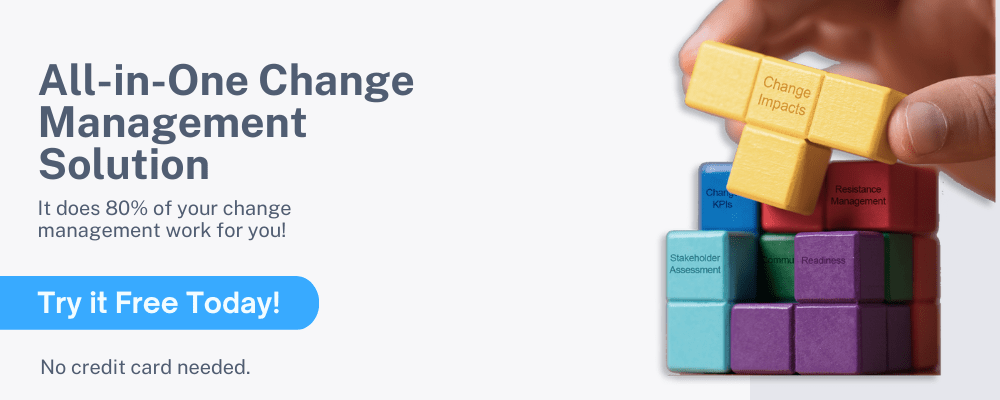Everything You Need to know About Adaptability in the Workplace: How to Adapt to Change
Organizational change happens continuously, and the drivers can be anything from technology innovation to cost-cutting measures.
While there are many different reasons for organizational change, a key component to realizing a successful transition is the ability to adapt to change by those impacted. This is typically the organization’s employees, aka “stakeholders.”
Many conventional change methodologies note the same common fact: If the people in an organization don’t change, then the organization itself can’t change.
Adapting to change in the business environment can be challenging. People have a routine and certain way of doing things, and when that’s disrupted, it can cause anxiety, frustration, and resistance to the change being enacted.
Change itself is hard. Ask anyone that’s tried to keep up a new fitness routine or quit smoking. Changing those habits isn’t easy, even if you’re the one driving your own change.
Adapting to change at work has another factor thrown in that can make the process even more difficult, which is that employees often have no control over the change. They didn’t choose it.
If you want to drive a successful change project and get past resistance to change, you must understand the ways to teach employees how to adapt to change in the workplace and embrace the change.
In this AGS insight article, we’re going to explore:
- Why is change so hard?
- Why is adaptability important in the workplace?
- How to adapt to change at work
Why do as many as 70% of change projects fail? Lack of adaptability in the workplace and the failure to transition employee resistance into support for a change.
Helping people adapt well to change at work is one of the most important pieces of change management and vital to the success of any change project, no matter what it is.
See Also: Helpful Tips for Dealing with Change in the Workplace
Overview | Why is Change So Hard?
First, let look at why change itself is so hard.
Whether your favorite Friday night pizza place just closed, or you have to merge departments at work, examples of adapting to change can differ widely.
How well you adapt to new situations can depend in part on your personality. Some people enjoy the unpredictability and excitement of a new change in their life, while for others, it can be quite unsettling to move out of their routine.
Not everyone handles change in the same way, but for a majority of people, it can be stressful and difficult.
What makes it so difficult for people to adapt to changes and learn new things? One of the main reasons is habits.
We adopt many habits in our daily routines at home, school, and work. According to a study by Duke University, as many as 45% of our daily behaviors are done automatically by habit.
We often don’t realize how ingrained those habits are until we have to change them. Suddenly the day isn’t quite so easy; your brain has to work harder, and adapting to change in the workplace can be uncomfortable and overwhelming.
Your mind and body want to follow the old routine, and you have to stop yourself. How to adapt to change takes time, but we’re often asked to change quickly, which leaves a problematic gap in-between breaking old habits and forming new ones.
At Work | Why Is It Hard to Adapt to Change?
Change in your personal life is hard enough to adapt to, but as we mentioned, adapting to change at work takes on a completely different dimension. Employees often feel they are being forced to change and have no control over the process.
The ability to adapt to change at work can also involve interpersonal and departmental relationships. For example, if someone an employee doesn’t respect is leading the change, they can be more apt to resist than if it’s someone they like.
Adapting to change in the business environment can also make employees fear for their livelihood. They may worry that if they can’t transition successfully, it can mean a demotion or worse.
Employees can also be influenced by their managers and supervisors. If their boss doesn’t support a change, then knowing how to adapt to change in the workplace becomes much more difficult for them.
The following are some of the main reasons that adaptability in the workplace can be so hard when there’s an organizational change.
There is a Loss Involved
If you want to adapt well to change or help someone else with adaptability in the workplace, you have to acknowledge that change involves loss. An employee could be losing a favorite co-worker (if there are layoffs) or may be losing a routine that they’ve become comfortable with for years.
Any type of loss brings up feelings of sadness for what will no longer be there, as well as the frustration that they have to change a way of doing things that have become a familiar habit.
Fears Can Drive Resistance
Employees hearing about a change to their daily routine can immediately jump to a pretty strong emotion, which is fear. They can be afraid of how to adapt to change at work, what the process will mean, and whether their workload is going to be more difficult.
Habits are Hard to Change
The Lewin Model of change management discusses the change in three stages, Unfreeze, Change, and Freeze. It acknowledges that habits will need to be undone (or unfrozen), new behaviors taught, then those new behaviors refrozen into new habits.
It’s not always easy for people to adapt to changes and learn new things because it means having to undo habits and behaviors they’ve had for years.
It’s Not Just About You
Examples of adapting to change in the workplace either successfully or unsuccessfully always involve more than a single person. A person will have co-workers, supervisors, and others in their organization that are also going through the challenge of how to adapt to change.
How others react to the change, how much leadership supports the change, and the expertise of the change management team, all play a role in adapting to change in the workplace and how easy or difficult it can be.
Don’t Miss: Change Management Interview Questionnaires with Answers
Why Is It Important to Adapt to Change in the Workplace?
Employees with the ability to adapt to change in the workplace are going to be more successful and sought after. This is because change is inevitable, and those that can be flexible and agile when it happens help drive organizations forward.
When organizations remain stagnant and don’t change, they can quickly be left behind the competition.
One example of not adapting to change is the video rental industry, which used to tout major players like Blockbuster and Movie Gallery. They did not change quickly enough when the move to online steaming media came and ended up being replaced by innovators like Netflix.
Why is Adaptability Important in the Workplace?
Adapting to change in the business environment provides an opportunity to be part of the innovation and continual evolution process that firms go through regularly in today’s digital age.
Change happens for a number of reasons, which also results in it happening more often. Examples of adapting to change and need for change include:
- Merger/acquisition
- Expanding operations
- Adding a new product/service
- Digital innovation
- Adjusting to economic and consumer changes
- Reducing costs
- Improving customer service
- Adapting to a remote workforce
The bottom line is that change is likely to happen regardless of your answer to the question, “How well do you adapt to new situations?” and if you don’t learn how to adapt to change in the workplace successfully, you’re bound to run into problems and may end up unhappy about each change that happens.
When you adapt to changes and learn new things with a positive attitude, you not only help yourself, you’re also making yourself more valuable to your organization.
Related: The Importance of the ITIL Change Management Process Flow
Overview | How Do I Adapt to Change?
Adapting to change at work starts by looking at how you adapt to change in general. Understanding your own feelings about routines and change can help you identify how to adapt to change more easily.
We’re going to take a look at the Myers-Briggs personality types and how each will adapt well to change or find it challenging. How to adapt to change at work has a lot to do with the personal feelings about change an individual has.
How well do you adapt to new situations? You can find out by finding your Myers-Briggs personality type indicator (MBTI®) and then reading the summaries below.
ISTJ (Quiet, serious, practical, dependable)
The ISTJ can support adapting to change in the workplace if they’ve been given a logical reason for the change. They enjoy routine and stability, so they need time to process a change before they can feel comfortable with it.
ISFJ (Quiet, friendly, responsible, conscientious)
This personality type enjoys routine, and as long as they’re clear on how and when that routine will be changing, they have the ability to adapt to change well. If change is thrust on them unexpectedly without much communication, they can become anxious.
INFJ (Looks for meaning in ideas, organized, vision-driven)
The INFJ gets excited when thinking about how to adapt to change at work but needs to look at both the positives and negatives before they decide to support a change. They’ve got a talent for coming up with a change vision or mission statement that can help drive excitement.
INTJ (Goal-oriented, see patterns, skeptical, independent)
The talent of this personality type is the ability for strategic long-term planning. They can adapt well to change but need to have all the facts on potential positive and negative impacts and don’t like sudden, unexpected changes.
ISTP (Flexible, problem-solver, values efficiency, analytical)
Adaptability in the workplace can come easily to the ISTP personality, but they want to know that logical, rather than emotional, reasons are driving the change. They like to have time to analyze the data and completely understand the impacts of the change.
ISFP (Sensitive, friendly, sensitive, do not like conflict)
When asked, “How well do you adapt to new situations?”, the ISFP may say that it depends upon the circumstance. They can feel flustered by a change and need plenty of support to understand how it benefits them.
INFP (Idealistic, loyal, adaptable, flexible)
This personality type can be another that’s particularly good at adapting to change in the business environment. However, they don’t like to feel pushed and need time to work out how the change is going to impact them and those they work with.
INTP (Logical, adaptable, analytical, skeptical)
INTPs are adaptable, but also analytical, which means they need to be presented with information about the change and why it’s happening, so they have time to process it. After that, they can end up adapting to change at work quite well.

Adaptability in the Workplace
ESTP (Flexible, tolerant, results-focused, spontaneous)
This personality type can become bored with a routine and too much repetition, so they adapt to changes and learn new things very easily. They’re another of the personality types that like to be involved in the change and not feel pushed into it.
ESFP (Outgoing, friendly, flexible, enjoys working with people)
The ESFP can easily grasp the benefits of a change, and they enjoy variety in their work. They can be one of the better examples of adapting to change if they don’t feel like it’s forced on them, but they have some type of input.
ENFP (Enthusiastic, imaginative, need affirmation, spontaneous)
This personality type gets easily bored by routine and enjoys variety, so they have a great ability to adapt to change and are enthusiastic about it. It’s important to have rewards and milestone achievements in place to provide affirmation and keep an ENFP motivated.
ENTP (Ingenious, stimulating, outspoken, bored by routine)
This is another of the personalities that is great at adapting to change in the workplace. They welcome new projects, and their outspoken nature makes them a great change champion.
ESTJ (Realistic, practical, organizational skills, detail-oriented)
This personality type takes a practical approach to adaptability in the workplace. While they may not be a cheerleader for the change, they’ll accept it and be helpful. They do like to be involved and are excellent at strategy planning and organizing steps for the change project.
ESFJ (Conscientious, cooperative, enjoys harmony, enjoys working with others)
ESFJs can become anxious about a change. They enjoy routine and the comfort of consistency. If they can be reassured that the change will be positive for them and their close colleagues, they can learn how to adapt to change.
ENFJ (Empathetic, responsible, attuned to emotions of others, inspiring leader)
This personality type can be a great driver for change and help to inspire others on how to adapt to change in the workplace. They just have to be careful not to get overwhelmed by getting wrapped up in everyone’s emotions and trying to make sure everyone has the same excitement about the change.
ENTJ (Decisive, leadership capabilities, forceful, enjoys learning)
This personality type is great for a change management team. They work well with the challenges and problem solving needed in adaptability in the workplace. They can come off a bit inflexible when it comes to implementing a change plan, so they are best when paired with an empathetic personality type.
How Do You Adapt to a New Situation?
Adapting to change in the business environment means learning how to adjust to new situations. This can bring on a range of emotions, from panic to excitement.
Knowing how you adapt to a new situation, including your adaptability in the workplace, can be a big help in understanding how you react to change. It can also give you targets of your behavior you can work on to make adapting to change in the workplace easier.
Do You Adapt Well to New and Challenging Situations?
Begin by looking at the past change in your life and how well you’ve adjusted to new situations. Include both welcomed changes and challenging situations.
Look at both adaptability in the workplace and adaptability to changes in your personal life. Both will give you insight into how you personally handle new situations.
Here are a few typical change situations to consider when trying to understand the answer to, “How well do you adapt to new situations?”:
- New family member
- Promotion at work
- Additional responsibility be added to your workflow
- An emergency, like a power outage
- A friend or family member moving away
- Trying to change a habit
- New manager
Do you initially go to panic and anxiety when faced with a new situation or challenge?
Do you try to avoid the issue if possible until you can figure out how to deal with it?
Do you meet a challenge head-on, excited for the change in routine?
Whatever your first gut response for how to adapt to change in a new situation, there are some things you can do to help you manage that change more smoothly to reduce stress and increase your ability to adapt to change.
Keep Emotions in Check & Look at Facts
When a new and challenging situation comes up, it’s common to react emotionally. But those emotions can often get in the way of adapting to change in the workplace or anywhere else.
Set aside the emotional response for a few minutes and focus just on the facts of the situation. It may not be as bad as you thought, and going into analytical mode can help unfreeze you from a state of panic or stress.
For Every Negative You Think of, Match It With a Positive
Adaptability in the workplace relies on keeping a positive attitude about a change. It’s natural to start thinking of all the negative things that can happen when hit with a new situation, but that negativity can keep you from the ability to adapt to change.
For every negative scenario that comes to your mind about a change, think up a positive one as well. This will help you stay balanced and realize that not every change means a bad outcome.

Why is Adaptability Important In the Workplace?
Ask Questions, Gather Information
If you’re one of those personality types that craves change and rushes headlong into it, you may need to take a step back to ensure you’re finding the most productive ways of how to adapt to change.
Control the impulse to immediately start acting on a new situation and gather some information first by asking questions, so you can productively exhibit adaptability in the workplace.
Take Things One Step at a Time
A new situation or challenging change can become overwhelming if you try to “eat the whole elephant” at once. This means instead of thinking of everything the change encompasses, think about just the first step. Once that’s complete, go onto the next step.
Adapting to change in the workplace or any other type of change is much less stressful if you take it one step at a time, and just do the next right thing to move through the transition.
How Do You Adapt to Change at Work?
Adaptability in the workplace comes more easily to some people than others, but that doesn’t mean you can’t learn to become more adaptable, even if you’re one of the personality types that treasures routine and consistency.
Adapting to change at work can be challenging because you often don’t have an option when organizational change is happening. You can feel powerless and blindsided by some change. On the flip side, the change may be an exciting one, such as a move to a larger office.
How to adapt to change adeptly is to take all changes (welcome and unwelcome) with an open mind and an understanding that you do have control over one of the most important parts of the change, your attitude towards it.
“Life is 10% what happens to you and 90% how you react to it.” – Charles R. Swindoll
The quote from Swindoll is an excellent reminder that as uncontrollable as change many feel to you at times, adaptability in the workplace is very much about your attitude and reaction to the change.
Here are some ways to improve your ability to adapt to change at work:
- Ask questions instead of assuming the worst
- Give yourself a chance to process the change before reacting
- Keep an open mind
- Find small ways to control how you implement change
- Give yourself time to change habits and behaviors
- Envision the best-case scenario about the change
- Look for support from your team
- Don’t judge this change by a bad experience with a past change
- Be prepared to change, so you’re never caught off guard
Popular Article: Best Change Management Certificates and Course
How Long Does It Take to Adapt to Change?
Adapting to change in the workplace can take time, so it’s important to be patient and understand that not everyone can adopt new habits in the same timeframe.
Some employees may seem like they’re having no trouble adopting the new way of doing things, but for others, it can take several weeks for those new habits to become cemented into their daily routine.
It’s important for anyone heading up a change project to provide ongoing support after the go-live date to ensure the change is sustained and everyone has the time they need to adapt to the change in the business environment.
According to a study published in the European Journal of Social Psychology, the average time it takes for a new behavior to become a habit is 66 days.
The study also found that individuals can have a new behavior become automatic in as little as 18 days and as much as 254 days.
On average, it’s a good idea to plan about 2.5 months for adapting to change at work and cementing the new behaviors as a routine habit.
Conclusion: Adaptability in the Workplace – Adapting to Change
In today’s always evolving world, adapting to change in the workplace is a must. Organizations will inevitably go through change at some point, and for most, it happens regularly as they adapt to new technology, economic environments, and more.
The trick to being good at adaptability in the workplace is to understand how you naturally react to change and challenging situations. Then use that knowledge to help adopt better ways of dealing with change that reduce your anxiety and stress.
While you may not be able to control the fact that the change is happening or what is changing, you can absolutely control how you react to the change and how you let it impact you emotionally.
By keeping an open mind, controlling what you can, and staying positive, you can improve your ability to adapt to change, making you a more valuable asset to your organization and reducing the negative impact of change on your daily work life.
Note: Content on OCM Solution's ocmsolution.com website is protected by copyright. Should you have any questions or comments regarding this OCM Solution page, please reach out to Ogbe Airiodion (Change Management Lead) or the OCM Solution Team today. OCM Solution was previously known as Airiodion Global Services (AGS).
Images: Microsoft 365 Clip Art Image(s) (Bing images licensed under the Creative Commons license system.), https://www.pexels.com/photo/man-wearing-brown-suit-jacket-3184339/

